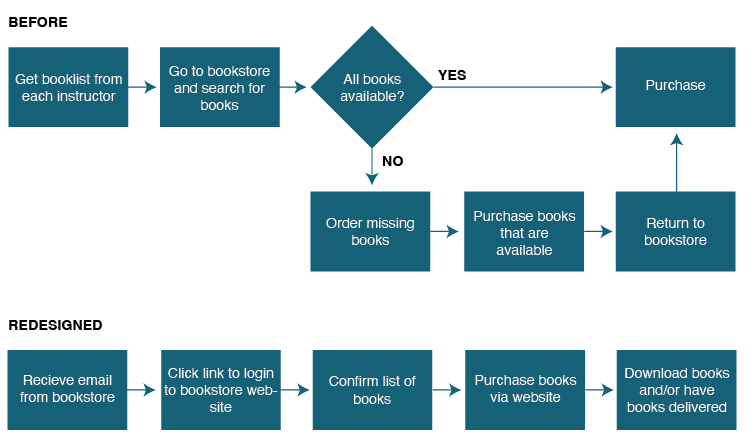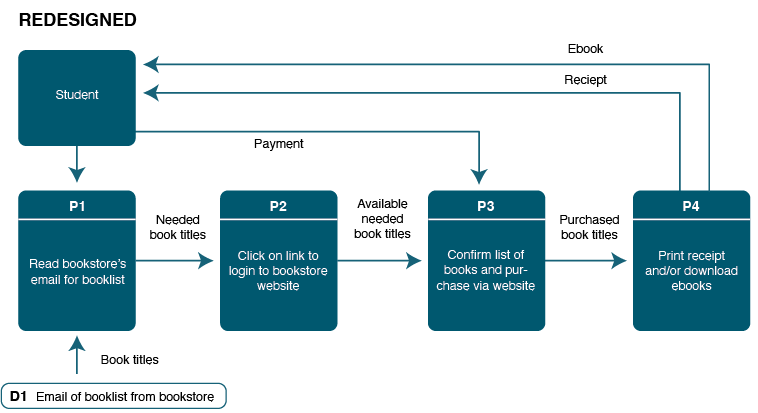11.3. Business Process Management
Organizations that are serious about improving their business processes will also create structures to manage those processes. Business process management (BPM) can be thought of as an intentional effort to plan, document, implement, and distribute an organization’s business processes with the support of information technology. BPM is more than just automating some simple steps. While automation can make a business more efficient, it cannot be used to provide a competitive advantage. BPM, on the other hand, can be an integral part of creating that advantage.
Not all of an organization’s processes should be managed this way. An organization should look for processes that are essential to the functioning of the business and those that may be used to bring a competitive advantage. The best processes to look at are those that include employees from multiple departments, those that require decision-making that cannot be easily automated, and processes that change based on circumstances.
To make this clear, let’s take a look at an example.
Business Process Management in Retail Example
Suppose a large clothing retailer is looking to gain a competitive advantage through superior customer service. A task force is created to develop a state-of-the-art returns policy that allows customers to return any article of clothing, no questions asked. The organization also decides that, in order to protect the competitive advantage that this returns policy will bring, they will develop their own customization to their Enterprise Resource Planning (ERP) system to implement this returns policy (more on ERP systems in this chapter).
In preparation for the rollout of the system, all customer-service employees are trained, showing how to use the new system and specifically how to process returns. Once the updated returns process is implemented, the organization will be able to measure several key indicators about returns that will allow them to adjust the policy as needed. For example, if it is determined that many women are returning their high-end dresses after wearing them once, they could implement a change to the process that limits the return period to 14 days from the original purchase date. As changes to the returns policy are made, the changes are rolled out via internal communications, and updates to the returns processing on the system are made.

If done properly, business process management will provide several key benefits to an organization, which can be used to contribute to competitive advantage. These benefits include:
- Empowering employees. When a business process is designed correctly and supported with information technology, employees will be able to implement it on their own authority. In our returns-policy example, an employee would be able to accept returns made before fourteen days or use the system to make determinations on what returns would be allowed after fourteen days.
- Built-in reporting. By building measurement into the programming, the organization can keep up to date on key metrics regarding their processes. In our example, these can be used to improve the returns process and also, ideally, to reduce returns.
- Enforcing best practices. As an organization implements processes supported by information systems, it can work to implement the best practices for that class of business process. In our example, the organization may want to require that all customers returning a product without a receipt show a legal ID. This requirement can be built into the system so that the return will not be processed unless a valid ID number is entered.
- Enforcing consistency. By creating a process and enforcing it with information technology, it is possible to create a consistency across the entire organization. In our example, all stores in the retail chain can enforce the same returns policy. And if the returns policy changes, the change can be instantly enforced across the entire chain.
Business Process Reengineering
As organizations look to manage their processes to gain a competitive advantage, it is also important to understand that existing ways of doing things may not be the most effective or efficient. A process developed in the 1950s is not going to be better just because it is now supported by technology. In 1990 Michael Hammer published an article in the Harvard Business Review entitled “Reengineering Work: Don’t Automate, Obliterate.” This article suggested that simply automating a bad process does not make it better. Instead, companies should “blow up” their existing processes and develop new processes that take advantage of the new technologies and concepts (Hammer, 1990).
Business process reengineering (BPR) is not just taking an existing process and automating it. BPR is fully understanding the goals of a process and then dramatically redesigning it from the ground up to achieve dramatic improvements in productivity and quality. But this is easier said than done. Most of us think in terms of how to do small, local improvements to a process; complete redesign requires thinking on a larger scale.
Unfortunately, business process re-engineering got a bad name in many organizations. This was because it was used as an excuse for cost cutting that really had nothing to do with BPR. For example, many companies simply used it as a reason for laying off part of their workforce. However, today many of the principles of BPR have been integrated into businesses and are considered part of good business-process management.
Reengineering the College Bookstore Example
The process of purchasing the correct textbooks in a timely manner for college classes has always been problematic. Now with online bookstores competing directly with the college bookstore for students’ purchases, the college bookstore is under pressure to justify its existence. But college bookstores have one big advantage over their competitors, namely they have access to students’ data. Once a student has registered for classes, the bookstore knows exactly what books that student will need for the upcoming term. To leverage this advantage and take advantage of new technologies, the bookstore wants to implement a new process that will make purchasing books through the bookstore advantageous to students. Though they may not be able to compete on price, they can provide other advantages such as reducing the time it takes to find the books and the ability to guarantee that the book is the correct one for the class. In order to do this, the bookstore will need to undertake a process redesign.
The goal of the process redesign is simple. Capture a higher percentage of students as customers of the bookstore. After diagramming the existing process and meeting with student focus groups, the bookstore comes up with a new process. In the new process the bookstore utilizes information technology to reduce the amount of work the students need to do in order to get their books. In this new process the bookstore sends the students an e-mail with a list of all the books required for their upcoming classes. By clicking a link in this e-mail the students can log into the bookstore, confirm their books, and complete the purchase. The bookstore will then deliver the books to the students. And there is an additional benefit to the faculty: Professors are no longer asked to delay start of semester assignments while students wait for books to arrive in the mail. Instead, students can be expected to promptly complete their assignments and the course proceeds on schedule.
 Here are the changes to this process shown as data flow diagrams:
Here are the changes to this process shown as data flow diagrams:

Images adapted from Information Systems for Business and Beyond by D. Bourgeois CC-BY-NC
“Chapter 8: Business Processes” from Information Systems for Business and Beyond (2019) by David Bourgeois is licensed under a Creative Commons Attribution-NonCommercial 4.0 International License, except where otherwise noted.


